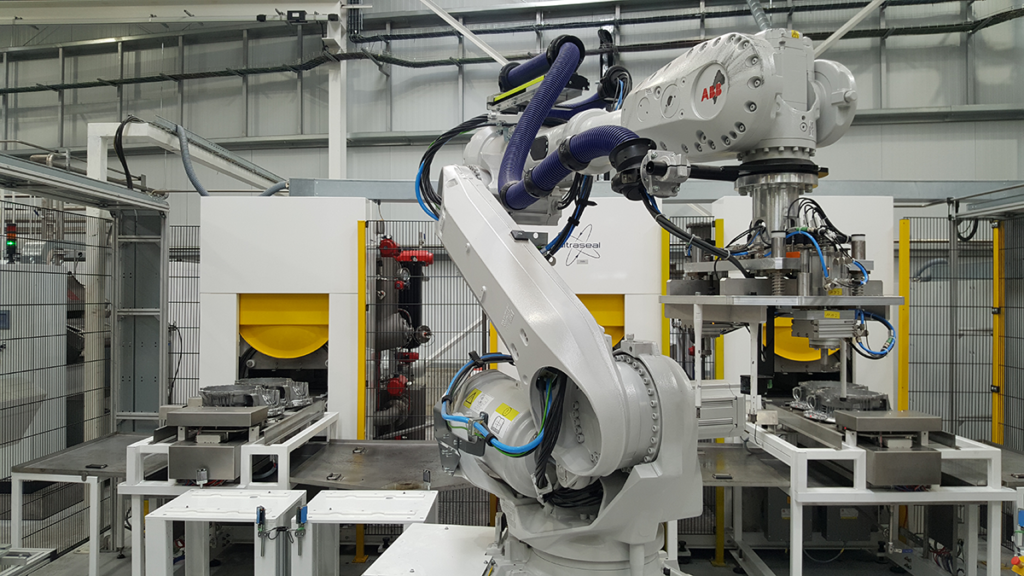Robotic automation is not a new concept within engineering and manufacturing. Businesses are always looking for new ways to improve costly overheads, speed up production times and ensure long-term sustainability. Within the automotive industry, where the manufacturing of high volumes of critical powertrain components is increasing, the need for automation is significant. Hannes Mühlbacher, International Sales Manager at Ultraseal International Group Limited, discusses how an automotive component manufacturer used robotic vacuum impregnation to seal porosity, minimize scrappage and increase throughput, while also significantly reducing costs.
The challenge of continued sustainability.
The automotive industry is continually striving for lighter-weight vehicles. By reducing overall vehicle weight you increase the performance and fuel economy, reducing fossil fuel consumption and generating a smaller carbon footprint. Advances in technology have meant that die casting is seen as one of the main solutions for manufacturing lightweight aluminium parts such as engine blocks, transmission cases, e-motor housings, and structural parts.
The challenge, however, comes from the issue of porosity, which is a defect that causes several issues with die casting, as microscopic voids in the metal can lead to leak paths and reduce the density of the cast components. Left untreated this can lead to costly scrappage, creating waste inefficiencies in materials, energy, and production time. It can be even more of an issue for parts that need to be air or fluid-tight such as cooling systems.
Human Vs robotic automation.
As Industry 4.0 s evolves there is increasing adoption of robotic automation. When it comes to porosity sealing and vacuum impregnation, automated systems can reduce cycle times and speed up the process with increased efficiency and production volumes. The subject of operator safety is critical, and the use of automation reduces the risk of operator injury from handling and loading components.
While many industries are yet to fully embrace the benefits that Industry 4.0 implementation could bring, elements of the smart factory are increasingly commonplace. For the automotive industry, where levels of digital adoption are high, innovative technology and IoT-connected devices offer proven benefits over more traditional manufacturing processes.
What is encouraging is that investment in automation is increasingly affordable and available to organizations of every size. Such systems often offer a fast return on investment, reducing floor space and allowing production processes to run for longer periods.
An automated solution: The Nemak experience
One company that has embraced automation when it comes to porosity sealing is Nemak, a leading provider of innovative lightweighting solutions for the global automotive industry. Driven by a clear set of core values including customer focus and innovation their continued success depends on creating best-in-class vehicle components and achieving operational excellence.
For die casting companies, the risk of porosity is a common problem, and as such, some parts are scrapped or disposed of which can be a costly exercise. However, by using an Ultraseal front load system with robotic handling, Nemak achieved maximum sealing effectiveness and improved output quality. The addition of an Ultraseal inhibitor ensures that the appearance of the components remains unchanged, hence the parts retain their glossy appearance
Ultraseal was able to supply Nemak with the ideal turnkey impregnation solution which has met the customers need for increased production throughput, reduced energy consumption and most importantly a reduced carbon footprint.
Latest solutions to a worldwide issue.
Ultraseal’s front-load rotational processing method has been developed because of the market requirement to impregnate fully machined castings. This clean, neat, modern compact system design ensures maximum cleanliness of Nemak’s castings.
Ultraseal has developed unrivalled recycling technology that enables its sealants to be recovered from the cold wash solution. Typically, 90% of non-recycling sealants that are consumed end up in the cold wash water and are ultimately wasted as effluent. Since the development of Ultraseal’s recycling technology, a high number of OEMs and first-tier suppliers have benefited significantly from sealant recycling rates of typically around 90%, which they can reuse. Naturally, this creates both commercial and environmental benefits.
The Ultraseal Sealant Recycling System (SRS) is a fully closed-loop system on the cold wash operation that eliminates regular wash water changes. This system provides cost-effective processing while reducing chemical waste and effluent disposal and treatment costs.
Porosity sealing and robotic implementation
The future of manufacturing will continue to develop with greater process automation. Robotic implementation, particularly when it comes to sealing porosity, will enable businesses to increase productivity. Not only that, but they can work towards improving their sustainability performance by reducing chemical and water usage.
By adopting best-in-class Ultraseal vacuum impregnation systems, manufacturers give themselves every chance to improve quality and sustainability, whilst reducing operating costs. However, for those not equipped to install a completely owned and automated solution to their site, Ultraseal offers on-site managed services and external service centres, allowing customers to access a solution that best fits their operational requirements.
